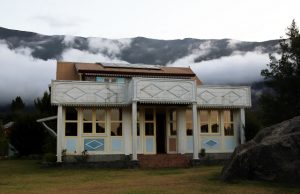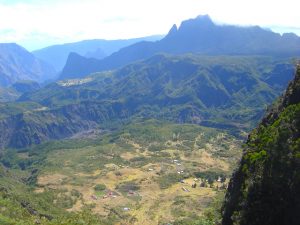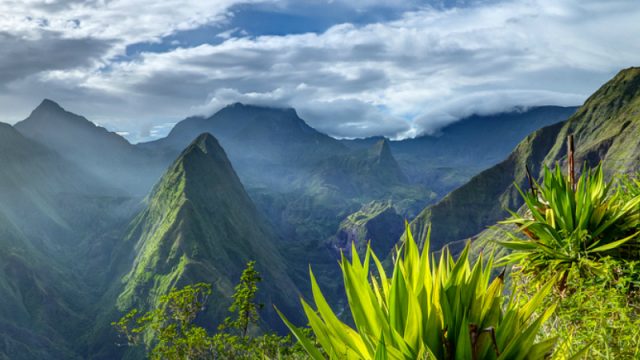Reunion Island, or Île de la Réunion, is a land of contrasts. The island is a French department, legally part of France, and yet it sits in the middle of the steamy Indian Ocean. The perimeter of the island is hot and sunny, with piping hot sand and water warm enough to bathe in, while the mountain interior – which boasts the highest point in the Indian Ocean – is cool and damp, often shrouded in mist.

Shutterstock
It’s certainly possible to enjoy a relaxing beach holiday on Reunion, lazing on the golden or black sand beaches and filling up on French pastries and wine. But the beaches are only a small part of what Reunion has to offer. A huge part of Reunion’s appeal sits higher – much higher – nestled inside the towering volcanic calderas that formed Reunion in the first place. Those calderas, or cirques, offer an amazing hiking experience. Reunion’s cirques and the surrounding areas have more than 1000 kilometers of hiking trails.
Reunion was formed a couple of million years ago over a volcanic hotspot. One of its volcanoes, Piton de la Fournaise, is still extremely active, spewing hot lava into the air to the delight of tourists lucky enough to fly over the volcano or hike around it from a distance.
But on the other side of the island is a long-extinct volcano, Piton de Neiges, surrounded by three cirques – Cirque de Mafate, Cirque de Cilaos, and Cirque de Salazie – and dotted with Creole villages. Cirque de Mafate is unique in that the entire cirque, which includes more than 140 kilometers of hiking trails, has no roads and is accessible only by foot and helicopter. The cirque is surrounded by unbelievably high walls, or ramparts, and offers some of the most beautiful hiking scenery on earth.
It’s possible to hike for several days, even a couple of weeks, in Mafate alone. Some routes require more fitness and hiking experience than others. But it is relatively easy to drive to Col des Boeufs on the edge of the Cirque de Salazie, walk from there to Mafate’s largest village of La Nouvelle for lunch, and walk back again, all in the same day. (See map of Mafate.) More planning is involved for those who want to venture further into the cirque.

Photo by Heather Mason
The best thing about hiking in Mafate is that walkers get all the benefits of hiking in a remote mountain forest without having to carry heavy tents and food on their backs. All of Mafate’s tiny villages and hamlets offer gîtes, the French word for hiking hostels, where travelers can spend the night in group-style accommodation, eat a delicious, home-cooked Creole meal, and have a basic breakfast before hitting the trails again the next morning.
Gîtes are quaint but very basic, with small bunk beds, minimal furniture, and shared bathrooms. (Some gîtes do offer en-suite accommodation but these rooms must be booked well in advance.) Hikers should also be aware that breakfast in Mafate is small and simple – usually some baguette slices with jam and coffee, juice, or tea – so it’s best to bring along protein-rich snacks for energy. The hills in Mafate are extremely steep and climbing them burns serious calories.
But the small beds and exhausting climbs are more than worth it for the jaw-dropping scenery: kilometer-high waterfalls, tiny villages sitting on plateaus, and row upon row of jagged mountain peaks. Nothing beats the feeling of cresting a huge peak and seeing nothing but mountains and emerald green valleys, all the way to the horizon.

Mafate, from above (Wikimedia Commons)
Staying in Mafate’s villages is also a unique experience, giving travelers the opportunity to interact with Reunion’s French-Creole people. Mafate’s villages were founded centuries ago by escaped slaves and poor whites, and in many ways the villages still feel far removed from the modern world with minimal electricity and other amenities. (The modern world comes rushing back, though, when helicopters from the coast swoop in to deliver food and remove bags of rubbish.) Note that French is the main language in Mafate and English is only minimally spoken. Basic gîte accommodation costs around 30-40 euros ($33 to $44) per night.
While it is definitely possible to hike Reunion’s cirques alone, they are best navigated with a local guide, especially for those who don’t speak French. (Find a list of Reunion guiding companies here.)
English-language travel resources for Reunion Island are sparse. Visit the Reunion Island Tourism site for information on travel, hiking, and accommodation booking in Mafate and the rest of the island.

